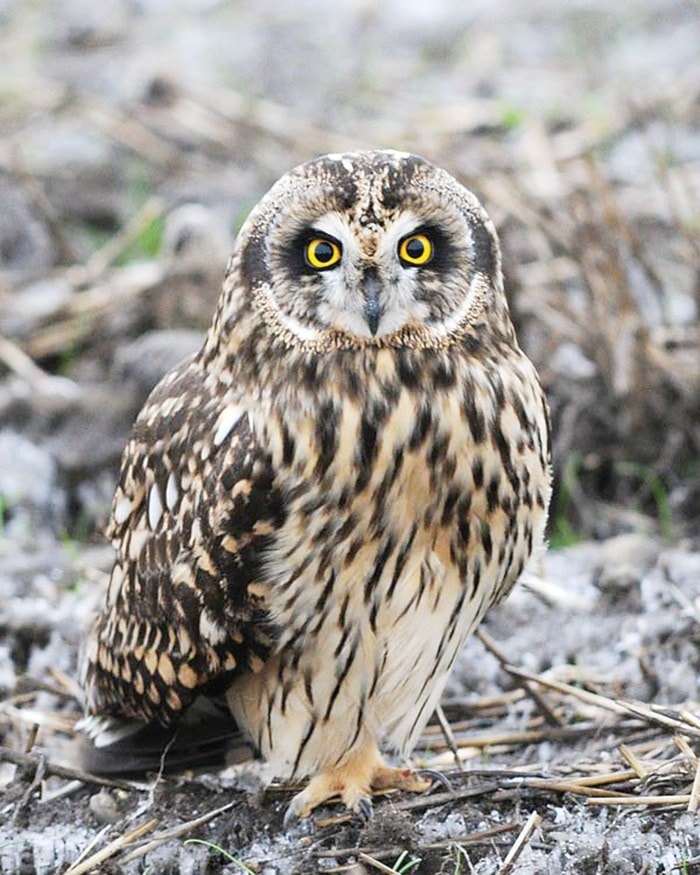Halloween is a time for ghosts, bats and other spooky things including owls that always have an air of mystery about them.
Since Halloween five owls have been admitted to M.A.R.S. including the diminutive northern pygmy owl, the midsized short eared owl and the largest of our local species – three snowy owls.
The snowy and short eared owls appeared to be exhausted and emaciated possibly from a tough flight during their winter migration; the pygmy was stunned after hitting a window and has now been released.
“Asio Flammeus” translated from Latin means “flame coloured horned owl” also known as the short eared owl.
This exquisitely marked bird is one of nature’s most beautiful owls; its face is outlined in white with small ear tufts that are usually carried flush to its head.
Large yellow eyes highlighted in black are quite hypnotic.
Short eared owls are perfectly camouflaged for the habitat they live in – from above they are tawny coloured and their breasts are buff, streaked with dark brown.
Once airborne these owls can easily be identified by their flight, they have slow loping wing beats that resemble a “tipsy moth”.
Nomadic by nature, short eared owls are found on every continent in the world except Australia and the Antarctic; they have adapted to a variety of habitats including grasslands, prairies, marshlands, alpine and even the tundra.
They are migratory by nature but only to the most southern areas of their territory, for local populations this would be as far south as northern Oregon.
They are now listed as a species at risk as much of their territory has or is being changed from open grasslands to farm or other agricultural land, and urban expansion.
Short eared owls have adapted to a variety of food but their favourite still remains the vole, which is a cross between a mouse and a mole.
These owls share the same problem facing snowy owls as their favourite voles’ (snowy owls love lemmings); they have dramatic highs and lows in their populations known as irruptive years, this means that some years the rodent population crashes and the young owls are forced to travel further afield in search of food.
Other years, including this one, there is a bonanza with huge numbers of rodents which in turn stimulates the owls to produce more eggs and successfully raise multiple young.
Unique hunters, short eared owls do not perch in a tree instead preferring a fence post from which they swoop down and fly a few metres above the ground.
When prey is spotted they hover and then drop down onto the startled animal.
Their nests are scraped out depressions on the ground lined with soft dried grasses and a few feathers.
Short eared owls are also partial to preying on birds which they ambush whilst hidden on the ground amongst the grass, they have no qualms about chasing off crows.
Diurnal and crepuscular, describes these owls as they hunt mainly at dawn and dusk, but they can also been seen during the day especially at Comox Valley farms and the old U.B.C. farmlands at Oyster River.
Another similarity between the short eared and snowy owls is their vocalization, neither owl “hoot” instead they have a repertoire of high pitched “yaps”, barks, sqeals and nasal meows as well as the usual “beak clacking” that is common to all owls when threatened.
During their mating ritual, short eared owls have another weird habit, they bring their long wings together under their bodies clapping them to produce a sound like a flag flapping in a stiff wind, at the same time they emit a noise like a “puffing steam engine”.
The young owlets have a perilous start to their life as they are prime targets for predation.
Their main predators include other owls, eagles, crows and ravens, hawks and ground mammals.
The females will adopt the “broken wing” trick by luring a predator away from the nest on foot only flying away when she thinks they are out of danger.
Short-eared owls’ low flight patterns also imperils them around roads as they are often hit by cars, and this time of year is especially dangerous for all larger raptors and long winged birds that need a clear runway in order to gain lift off and flight.
Please remember to be cautious on the roads at dusk and dawn when most wildlife are out hunting or foraging for food.
We encourage all students (and all adults) to check out our web site, www.wingtips.org and vote for us at Aviva and and our new funding initiative from B.C. Hydro.
You can also follow our patients recovery and find out which public events we will be attending.
With enough votes we could secure the funding we desperately need to upgrade our educational programs both in the schools and in our rehabilitation work.
To report injured wildlife please call 1-800-304-9968, for all other calls 250-337-2021.
